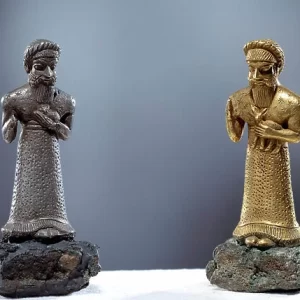At least 80 skeletons lie in a mᴀss grave in an ancient Greek cemetery, their wrists clamped by iron shackles.
They are the victims, say archaeologists, of a mᴀss execution. But who they were, how they got there and why they appear to have been buried with a measure of respect – remains a mystery.


They were found earlier this year in part of the Falyron Delta necropolis – a large ancient cemetery unearthed during the construction of a national opera house and library between downtown Athens and the port of Piraeus.
Few people have been able to get in to have a close look.
But on a rare tour of the site, archaeologists carefully showed Reuters the skeletons, some lying in a long neat row in the dug-out sandy ground, others piled on top of each other, arms and legs twisted with their jaws hanging open.
“They have been executed, all in the same manner. But they have been buried with respect,” Dr. Stella Chryssoulaki, head of excavations, said.
“They are all tied at the hands with handcuffs and most of them are very very young and in a very good state of health when they were executed.”
The experts hope DNA testing and research by anthropologists will uncover exactly how the rows of people died. Whatever happened was violent – most had their arms bound above their heads, the wrists tied together.
But the orderly way they have been buried suggest these were more than slaves or common criminals.
The cemetery dates from between the 8th and 5th century BC.
“It is a period of great unrest for Athenian society, a period where aristocrats, nobles, are battling with each other for power,” said Chryssoulaki.


One of the strongest theories is that they were supporters of Cylon, an Athenian noble and Olympic champion who staged an attempted coup in Athens in 632 BC with the help of his father-in-law, the tyrant of Megara.
The coup failed and Cylon hid in a temple of the Acropolis. He managed to escape, but the people who backed him were killed.
“Perhaps with the DNA tests that we will do on these skeletons we may confirm or not this hypothesis that these deceased, these young people could be … part of a coup … an attempt by a noble to take power by force,” said Chryssoulaki.
More than 1,500 bodies lie in the whole cemetery, some infants laid to rest in ceramic pots, other adults burned on funeral pyres or buried in stone coffins. One casket is made from a wooden boat.

Unlike Athens’ renowned ancient Kerameikos cemetery, the last resting place of many prominent ancient Greeks, these appear to be the inhabitants of regular neighbourhoods.
The dig is within a 170,000 sq m landscaped park, shadowed by the vast new modern library and opera house buildings being built by the Stavros Niarchos philanthropic foundation.
High-rise apartments dot the skyline to the north while a noisy motorway snakes by the site’s east side.
Chryssoulaki wants to see a museum built on the spot, as a monument to the daily lives of Athenians from another era.
“A cemetery is a first and last pH๏τograph in antiquity of those people that pᴀss from life to death,” she said





